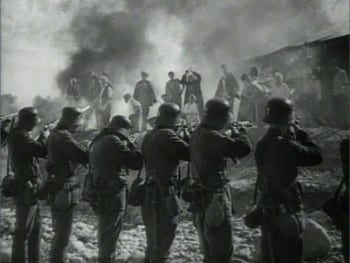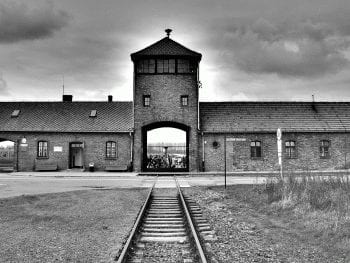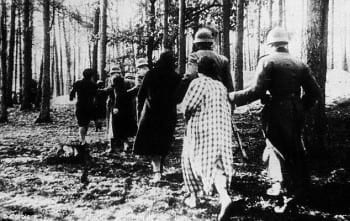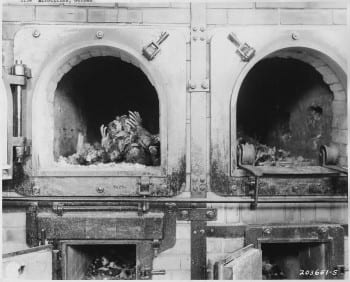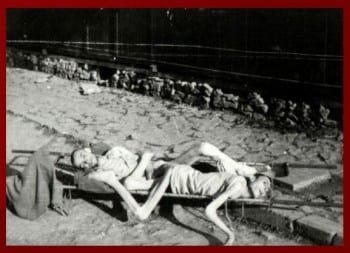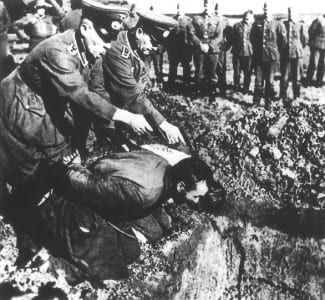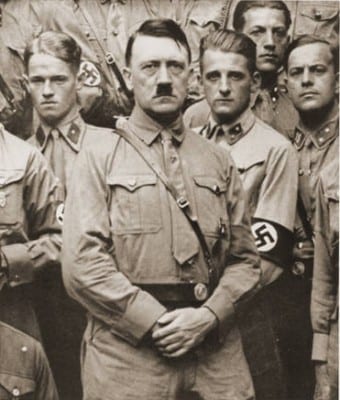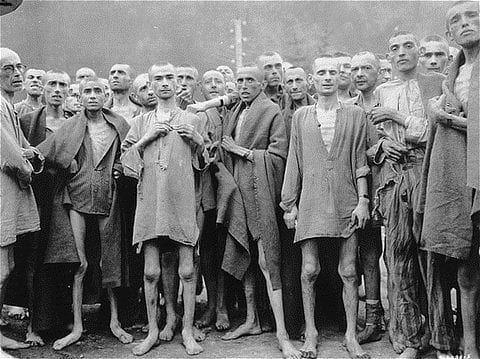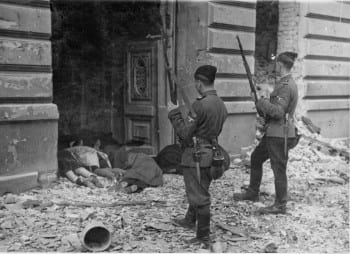UNDERSTANDING THE HOLOCAUST IN HISTORICAL PERSPECTIVE
MICHAEL FAULKNER
Part one of a two-part series.
“We should properly use the term ‘Holocaust’ to describe the policy of total physical annihilation of a nation or a people. To date, this has happened once, to the Jews under Nazism.”
—Yehuda Bauer, The Holocaust in Historical Perspective. 1978.
[dropcap]J[/dropcap]anuary 27 2015 marked the 70th anniversary of the liberation of Auschwitz in 1945, less than three months before the final collapse of the Third Reich and the end of the Second World War in May of that year. The extermination camp was liberated by the Red Army on its advance into Poland. In April the British and American armies liberated the camp at Bergen-Belsen and other concentration camps in Western Germany, and revealed to the world the first horrific film images of the genocide perpetrated by the bestial Nazi regime, which had taken the lives of so many millions during the preceding six years. From that time on all those throughout the world with access to the information, whether through the direct evidence of the newsreel camera or through various other sources, were aware that the Nazis had murdered in cold blood many millions of innocent people who were guilty of nothing other than having been born into one or other of particular ethnic groups deemed by the Nazis to be ‘unworthy of life.’
Since that time it has been impossible to deny knowledge of the genocide. It has been impossible to deny that it happened, or plausibly to claim that somehow it has been deliberately exaggerated. Attempts by some, almost always neo-Nazis and apologists for Nazism, to peddle such falsifications or denials, have met with the contempt they deserve. Such people are worthy of consideration only as subjects for study in the realm of psycho-pathology. But this does not mean that there is any consensus about how the Holocaust should be understood. In the perspective of history, and amongst historians who have specialized in studying it, there is still much controversy. Indeed, some historians still avoid using the term ‘Holocaust’, preferring to use the terms ‘Shoah’ or ‘Judeocide’. Then there is considerable disagreement about whether ‘The Holocaust’ should refer only, or primarily, to the genocide of the Jews. Such disagreements are quite apart from the tendency over recent years to describe as genocide, or attempted genocide, large numbers of other mass killings that have been perpetrated against innocent victims all over the world.
This article will concentrate primarily on two aspects of the subject: (1) To what extent, if at all, the Holocaust should be regarded as unique in history, and as a uniquely Jewish tragedy, and (2) How understanding of the Holocaust was influenced for three decades after 1945 by the ideological imperatives of the Cold War. Because any serious discussion of the issues raised will inevitably and quite properly involve both acute intellectual enquiry and strong emotional commitment, it is necessary to begin with an unequivocal statement of the standpoint from which the issues discussed will be approached.
The historian Eric Hobsbawm titled his history of what he called The Short Twentieth Century – 1914 – 1991, “The Age of Extremes.” He argues that after about 150 years of secular decline, the twentieth century, with the onset of the First World War, witnessed an upsurge of barbarism which by the 1990s had shown no signs of abating. Barbarism should be understood as the breakdown of the rules and moral standards governing relations between members of a civilized society, and more specifically, as the reversal of what he calls “the project of the eighteenth-century Enlightenment” – the existence of rules and standards of moral behaviour conducive to the pursuit of Life, Liberty and Happiness. According to Hobsbawm, between 1914 and 1990, the death toll from wars, genocides and various armed conflicts amounted to 187 million, approximately 9 per cent of the world’s population in 1900. “The Age of Extremes” was written in 1994 and does not include accounts of the Rwandan genocide or of slaughter involved in the break-up of Yugoslavia or the first Gulf war. And of course, the grim record has continued unabated into the present century with the invasion of Iraq and its catastrophic consequences now unfolding in all their horror.
Twentieth Century Barbarism
[dropcap]T[/dropcap]he Holocaust can only be understood within the context of the twentieth century’s descent into barbarism. But to contextualize it is neither to simply assimilate it to other genocides nor to attribute to it a special status, a uniqueness setting it apart from all others. For example, it has been argued by some who adopt the former approach that in the Soviet Union far more people perished in the man-made Ukrainian famine and the liquidation of the Kulaks during the collectivization of the 1930s than were murdered in the Nazi extermination camps. On the basis of the numbers involved they claim that the Soviet genocide was worse than the Nazi one. In this way the Holocaust may be subsumed with other genocides and possibly accorded a place in a hierarchy of horrors according to the numbers of victims. Some of those who argue that the Holocaust was unique see it as an almost supra-historical phenomenon, beyond the comprehension of the historian and essentially unfathomable to anyone who did not experience it. The problems with this are manifold. It de-contextualizes and mystifies the Holocaust. It follows logically that once there are no more living survivors of the death camps (and Auschwitz stands a symbol for them all) there will be no point in any further research into the Nazi Judeocide.
The Uniqueness of The Holocaust
[dropcap]T[/dropcap]he only approach to this subject which rests firmly on the ground of historical fact and historical truth is one which recognizes that the Holocaust was indeed unique in the sense intended by Yehuda Bauer, cited under the title of this article. This does not obviate the uniqueness of other cases of genocide – for example, the Armenian massacres of 1915 – within their specific contexts. The Holocaust is unique in that it is the only example in history of an attempt, based on a fanatical ideology, a firm intention and clearly conceived plan, to murder every member of a particular people – the Jews – and thereby to eliminate them forever from the face of the earth. This was a genocide which, had its operation been able to continue, would have been considered completed only with the total annihilation of the Jewish people. However horrifying were the massacres and persecutions of many millions of others at the hands of the Nazis – Poles, Russians, homosexuals (and political enemies)– all regarded as “sub-human”, no other people was singled out for complete extermination, “ausrottung” in the phrase used publicly by Hitler in his address to the Reichstag in 1939. The terrible fate of so many Gypsies is in some ways comparable, but it is not an exact parallel. Large numbers went to the gas chambers as “a-socials” but Gypsies who were integrated into the wider population were often ignored. There is, of course, a sense in which it remains almost impossible to grasp how such a barbaric enterprise could have been possible in a world that had grown out of the European Enlightenment, and particularly to have come out of a civilization that had contributed so much to it.
But there were those who, during the fateful years leading to the catastrophe, began to have a notion of what was to befall the Jews. According to Marxist historian Enzo Traverso, in 1938 “Trotsky predicted that a new conflict would lead to ‘physical extermination’ of the Jews.” Traverso also draws attention to the very last written work (Theses on Philosophy and history. 1940.) by the German-Jewish writer, Walter Benjamin, in which he “sketched the outline of a new vision of history in which the idea of catastrophe replaced the myth of progress.” Later that same year, 1940, both were dead, Trotsky murdered and Benjamin by his own hand. In 1942 the first serious (and in many ways still unsurpassed) Marxist study of the Nazi regime, Behemoth by another German exile, Franz Neumann, was published in the United States. The book was completed in 1941, just before the German invasion of the Soviet Union and therefore prior to the Wannsee Conference. In the chapter devoted to Nazi race theory and antisemitism, Neumann writes that “National Socialism is the first Anti-Semitic movement to advocate the complete destruction of the Jews. But this purpose is only part of a wider plan defined as ‘the purification of German blood’. In which barbarism and a few progressive features combine to form a repellent whole.”
Nazi Antisemitism
[dropcap]I[/dropcap]t is not easy to present concisely a clear and accurate account of the role played by antisemitism in the Nazi Weltanschauung, but it is essential to an understanding of the Holocaust. It goes without saying that Nazism was profoundly and fanatically racist. Its racism was inherited and refined from the pseudo-scientific hotchpotch of biological racism, social-Darwinism and eugenics theory which was rampant in central European pan-German nationalist circles prior to the First World War. With the collapse of the German Empire during the revolutionary upheavals of 1918-19, antisemitism became a rallying call for counter-revolutionary nationalism in Germany and Austria and a potent force in the European elites’ reaction to the Bolshevik revolution. The infamous forgery, The Protocols of the Learned Elders of Zion circulated widely and was widely believed despite its early exposure as a forgery. In desperate times desperate people, particularly the ruined middle classes, may be persuaded that the most preposterous myths are the truth. To understand what led to Auschwitz and the Holocaust one must grasp the full virulence of Nazi antisemitism. In this respect Nazism went far beyond most other variants of Fascism, such as the Italian or Spanish versions.
For Hitler and the Nazis, the Jews were not, as was initially believed on the Left at the time, simply a convenient scapegoat. The scapegoat serves a particular purpose and then may be cast aside. The Nazis, like other fascist movements, adopted much of the style and paraphernalia of the left-wing movements of the day, presenting themselves as revolutionaries fighting on behalf of the down-trodden “little man”. The Nazi claim to be involved in an eternal struggle for the survival and ultimate triumph of the “Aryan Race” against dark forces of destruction, may be regarded as a perverted version of the Marxist theory of class struggle, which would result in the eventual triumph of the proletariat and the construction of a socialist society.
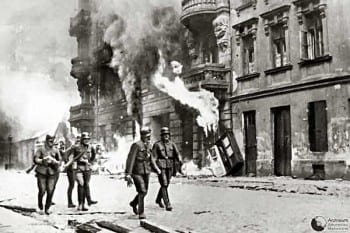
The Warsaw ghetto was the only major clash between Jewish organized resistance and the Wehrmacht. Fewer than 800 ludicrously armed fighters resisted for about 10 days the wrathful might of the Nazi military machine. According to the official report, at least 56,065 people were killed on the spot or deported to German Nazi concentration and death camps (Treblinka, Poniatowa, Majdanek, Trawniki).
The Nazis had to win the support of large sections of society who had been ruined – largely the middle classes and peasantry – but also, if they were to be successful, sections of the industrial working class. Their aim was not to bring about a radical change in the class structure but rather to leave in place, in a much strengthened position, a class of monopoly capitalists, while totally destroying the trade unions and political organizations of the working class and imposing a totalitarian regime. Although antisemitism was not the main propaganda appeal in the crucial months of Hitler’s seizure of power in 1933, it was firmly entrenched in their propaganda armoury. Attacks on the “plutocratic elites” – the Jews – were the Nazi storm troopers’ substitutes for the Communists’ anti-capitalist agitation. But the immediate enemy from the start, the ones the Nazis came for first, were the Communists. Then they came for the Socialists, and then the Trade Unionists. These were the first to fill the makeshift concentration camps that opened in 1933.
The Enemy: “Judeo-Bolshevism”
There can be no doubt that the Nazis believed their own propaganda. For Hitler “The Jews” were responsible for Marxism and Communism. It is impossible to read Mein Kampf without acknowledging that he was totally convinced of this. Thus, “Bolshevism” (the term was always used by the Nazis rather than “Communism” as it sounded more alien and frightening ) was a Jewish invention. The other one was Plutocratic Capitalism. The Nazis needed to do everything in their power to destroy the Communist party (KPD) and its influence in Germany. It was the largest of the European Communist Parties when they came to power. The Soviet Union was said to be in the grip of “Judeo-Bolshevism”. “The Jews” had invented Communism and their aim was to use it to destroy national movements and nations everywhere in order to achieve their age-old plan to dominate the world. In the fevered minds of Nazi ideologues, this drive for world domination was biologically determined, an adaptation from the ancient Christian demonology of the “Anti-Christ”.
In the Nazi racial hierarchy, the North European “Aryans”, represented pre-eminently by the Germans, stood at the pinnacle. The Jews were not at the bottom of the hierarchy. They were not a recognizable human race at all, not even “sub-humans”. The terms used to describe them were drawn from pathology – “bacillus”, “bacteria” “cancer” “plague”. That Hitler passionately believed this is clear from the opening of Mein Kampf, written in 1924 to his final Will and Testament twenty years later. The war against the Soviet Union was the decisive ideological struggle against “Judeo-Bolshevism” to which Hitler had always been completely committed. When victory had been achieved It would give Germany limitless “Lebensraum” in the East, fulfilling the wildest dreams of German Imperialism. It would supply a limitless supply of helots and slaves and it would enable him to embark upon the “Final Solution of the Jewish Question”. When, in December 1941, as the Wehrmacht was stalled before Moscow, it became clear that the Red Army would not be defeated so easily, implementation of the Final Solution could not be delayed.
[dropcap]O[/dropcap]nce propaganda had persuaded thousands of people to believe that all Jews were not simply a species of sub-humanity but a demonic, monstrous force with whom the German people and all other “healthy” races were locked in life-or-death struggle for survival, then it becomes clear how Auschwitz was possible. Amongst those commissioned to carry out the genocide there were some who believed, in their deluded way, that they were acting from high moral principles. The Viennese doctor, Ella Lingens-Reiner, who was herself imprisoned at Auschwitz for sheltering Jews in her home, reported, word for word, in her book Prisoners of Fear, 1948, a conversation she had in 1944 with an SS officer in the camp. He said: “It is quite possible that we shall lose this war and that all the wonderful things Adolf Hitler has created will be destroyed by the Unholy Alliance of our enemies. But there is one achievement that will stand, and future generations will thank us for it – there is one fact that will never be reversed….the fact that we have exterminated, root and branch, the mass reservoir in the East from which they were drawing fresh forces makes one thing certain: we have freed Europe from the Jews for good.”
Afterword: The Cold War and The Holocaust
It is of some interest to note that on Holocaust Memorial Day Vladimir Putin was not invited to attend the commemoration at Auschwitz Birkenau. In his speech at the ceremony, Polish premier Grzegorz Shetyna went out of his way to claim that Ukrainian and not Russian soldiers liberated the camp in 1945. Thus, the Cold War is back. Putin is the villain. The Soviet Union is airbrushed out of the titanic struggle they waged to defeat Nazi Germany. Soldiers of the Soviet Red Army cannot be named for what they were but need these days to be referred to as Ukrainians. This should probably receive fuller treatment in a separate article, but it is worth pointing out one or two things about the way the Holocaust was treated in most of the Western media between 1945 and the mid-1970s.
It is perfectly understandable that many, perhaps most, Holocaust survivors were very reluctant, or unable to talk about their experiences for many years. At any rate, it is well known that they didn’t. They only began to talk later. But, however one may account for that, there is something else that needs explaining. Why was it that documentary film of the liberation of the camps, after a brief initial showing, was put under wraps for decades? Why, for so many years, was so little heard about the Holocaust? The term itself did not come into common use until the 1970s. There is one obvious explanation: The Cold War. Consider this:
By 1948 the “totalitarian enemy” was no longer Germany, but Soviet Russia. Anti-communist hysteria gripped the United States. Amongst the people most prominent in Western Europe and the USA in their opposition to the re-armament of West Germany, were communists and others on the Left. Throughout the 1950s it was mainly the Left that exposed the return to positions of power and influence of former Nazis in West Germany. Organized visits to Auschwitz from Britain and Western Europe were often undertaken through the 1950s and 60s under the leadership of Communists. The McCarthyite witch hunts of the late 1940s and early 50s and the HUAC hearings were tainted with anti-Semitism. In both the US and Britain mainstream and conservative Jewish organizations were extremely nervous about becoming involved in public controversy about West Germany, which was from 1955 a member of NATO. In 1959 the national newspapers in Britain roundly condemned an exhibition on Nazi concentration camps that had opened in Coventry, sponsored by a former Belgian inmate of Buchenwald. It was condemned for arousing anti-German prejudice. Things changed somewhat in 1967 and even more so after 1973. Perhaps it will be possible to return to this theme later.
≥.
ABOUT THE AUTHOR
[box] Senior Contributing Editor Mike Faulkner is a British citizen. He lives in London where for many years he taught history and political science at Barnet College, until his retirement in 2002. He has written a two-weekly column, Letter from the UK, for TPJ Magazine since 2008. Over the years his articles have also appeared in such publications as Marxism Today, Monthly Review and China Now. He is a regular visitor to the United States where he has friends and family in New York City. Contact Mike at mikefaulkner@greanvillepost.com [/box]
[printfriendly]
What is $5 a month to support one of the greatest publications on the Left?
